Phnom Penh is considered the most beautiful of Indochina‘s French-built cities with many temples, museums, and other points of interest in and around the city. There has also been a recent surge in the number of new hotels, restaurants, bars, and nightclubs opening throughout the city, as well as a nightlife that promises fun and flavor.
General Information
With a population of 2,3 million, Phnom Penh, Cambodia’s capital, is the country’s most populous city. It has served as the country’s capital since the French protectorate of Cambodia and has grown to become the country’s economic, industrial, and cultural center. The Mekong, Bassac, and Tonle Sap rivers all meet in the capital.
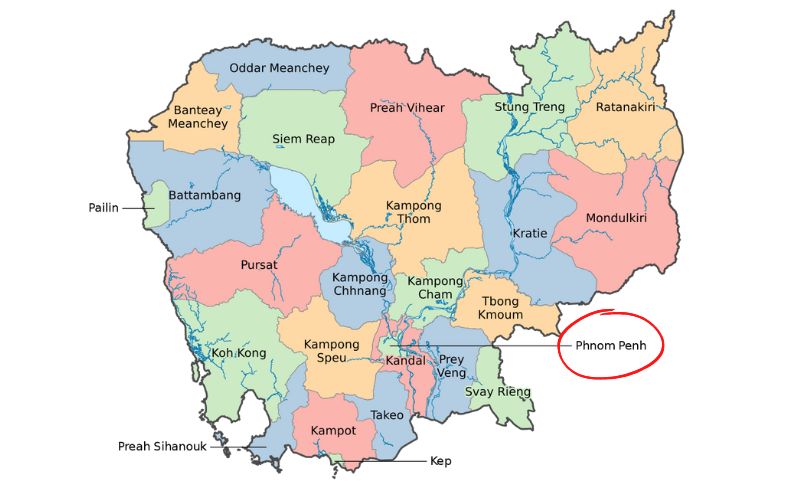
Location of Phnom Penh
The streets of Phnom Penh are charming. The Cambodian capital has plenty of history, architecture, food, and culture to offer, all wrapped up in the hectic, vibrant atmosphere of a major Asian city. While Phnom Penh’s turbulent past is on full display, the city is moving forward and embracing a bright future.
Weather and best time to visit
The climate in Phnom Penh is generally tropical, so it is hot all year with minor variations. The temperature ranges from 28 to 33 degrees Celsius on average.
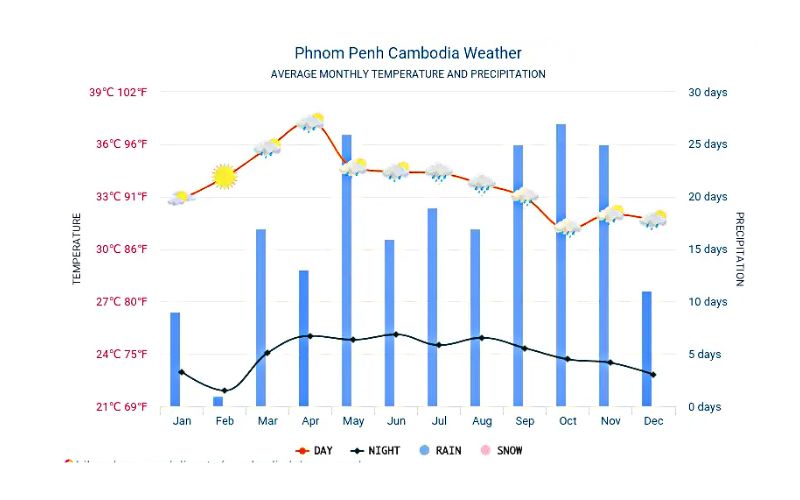
Phnom Penh Weather
There are three basic seasons in Phnom Penh: the cool season from November to January, the hot season from February to May, and the rainy season from June to October.
Rainfall amounts vary during the rainy, monsoon season. When the rain is heavy and many streets are flooded and muddy, it can be difficult to appreciate all of the sights in and around the city. Fortunately, the showers are brief, but you may be unlucky and experience a few days of continuous rain, which is more likely in May and September.
Because of the cooler temperatures, many tourists prefer to visit Cambodia between December and February. January is typically the coldest month, but temperatures remain in the 25°C to 30°C range.
The best time to visit Phnom Penh is between November and January when humidity levels are low and there is little chance of rain. Temperatures begin to rise in early February and continue to rise until the hottest month of the year, April, when temperatures frequently exceed 40 degrees Celsius (104 Degree Faradise). The wet season begins in May and lasts until October when the southwestern monsoon brings rain and high humidity. Despite being very wet, this time of year can be enjoyable.
Getting to & around Phnom Penh
The international airport in Phnom Penh, known as Pochentong and coded PNH, is located about 10 kilometers west of the city center. Most major regional airports, including Ho Chi Minh, Hanoi, Vientiane, Bangkok, Kuala Lumpur, Singapore, and Yangon, have direct flights.
Aside from planes, visitors can also travel to Cambodia by boat. The main ports are Phnom Penh and Sihanoukville. The Mekong Delta in Vietnam or the border crossing at Hat Lek and the boat from Koh Kong in Thailand are the two ways to get to Phnom Penh. Furthermore, travelers can now travel by train from Bangkok, Ho Chi Minh City, and Phnom Penh. However, the journey is slow, and you must take more than one train.
You can also take a taxi from Siem Reap, which costs around $65 to $100 but is more expensive during Cambodian holidays.
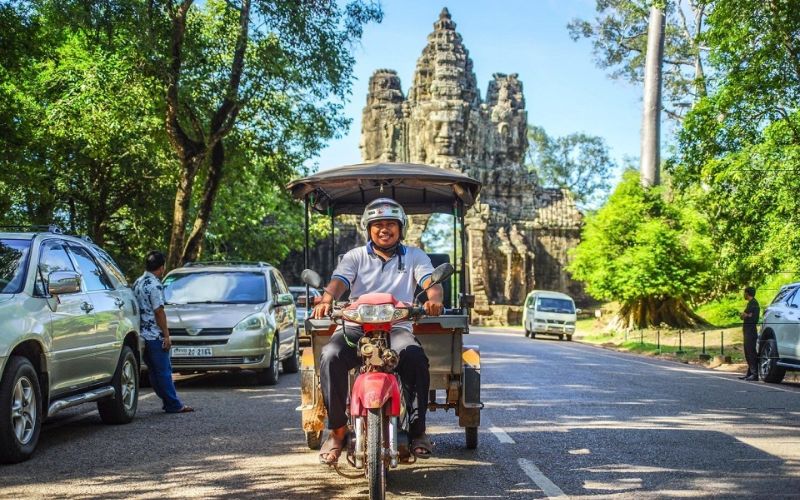
tuk-tuk in Cambodia
All in all, Phnom Penh is not a walkable city. Because Phnom Penh is divided into districts, getting around requires the use of a motorized vehicle. The most popular districts in Phnom Penh are Sisowath Quay (the grand Riverside Boulevard) and City Centre. The majority of locals, ex-pats, and tourists prefer to travel by bicycle, moto, tuk-tuk, or taxi. While you can cycle around the city, there are several landmarks in Phnom Penh that are only accessible by taxi, bus, or tuk-tuk. Tuk-tuks are the most comfortable way to get around Phnom Penh. Before you begin your ride, you and your driver should agree on a fare. If you want to hire a private car, contact us here.
Where to Stay in Phnom Penh
There are numerous low-cost hostels in Phnom Penh, as well as other excellent options such as traditional homestays, villas, and even high-end hotels and resorts.
Daun Penh and Chamkar Mon are the best places to stay in Phnom Penh because they are home to the city’s most iconic and must-see tourist attractions. This is also where you’ll find the Mekong River, the city’s best nightlife, and a plethora of restaurants serving a variety of cuisines.
Best places to visit & what to do in Phnom Penh
Royal Palace
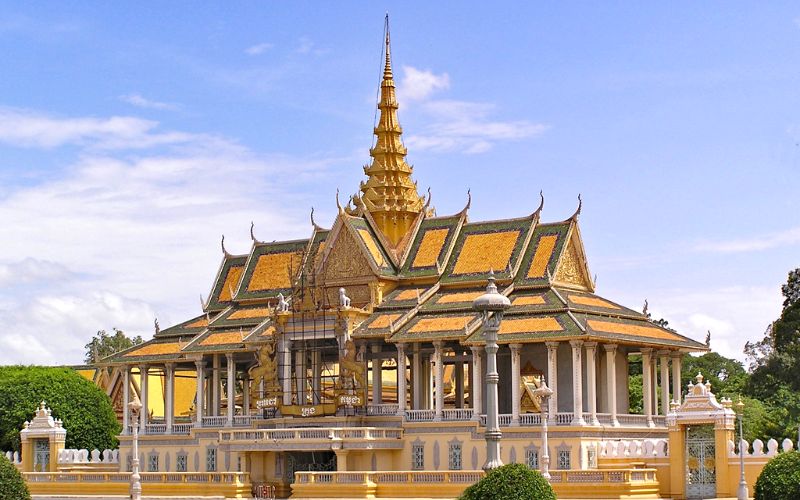
Royal Palace
Cambodia’s Royal Palace, which sits on the banks of the Mekong River, is one of the city’s most popular attractions. While it is the King’s official residence, visitors can still explore parts of the palace compound, such as the ceremonial Throne Room, ornate gardens, and the Chan Chaya Pavilion. The Silver Pagoda, an extravagant structure with a floor made of five tonnes of silver, must be the highlight.
Museums and memorials
In Phnom Penh, history can be found everywhere. Explore centuries of Cambodian treasures and art at the National Museum, or pay a visit to Choeung Ek, or the Killing Fields, a somber memorial to the 20,000 or so people killed by the Khmer Rouge in the 1970s. You can also visit the Tuol Sleng Genocide Museum, a political prison that is still surrounded by barbed wire and contains haunting images of its former inmates.
Cambodia National Museum
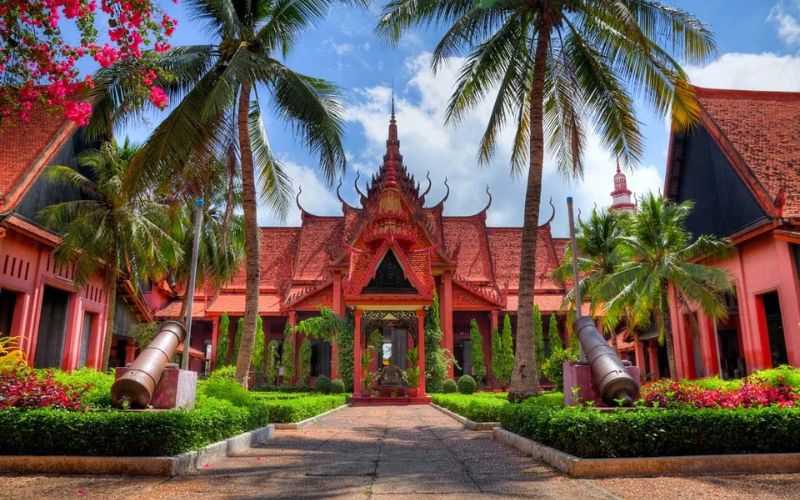
Cambodia National Museum
With more than 1,800 stunning pieces of ancient Khmer art on display inside, it’s a must-see for anyone interested in Cambodian history. Highlights of the museum’s galleries include the head of Vishnu, excavated near the vast Angkor Wat temple complex; the incredible Angkor collection, including statues from the Koh Ker and Angkor Thom temples; a large-scale exhibition of relics from the pre-Angkor period.
Killing Fields of Choeung Ek
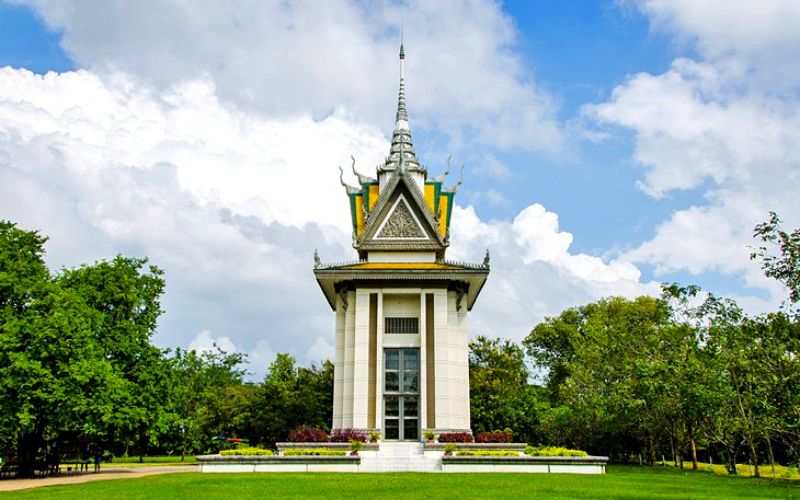
Choeung Ek
The Choeung Ek Killing Fields are a stark reminder of the horrors of the Khmer Rouge, whose brutal regime aimed to turn Cambodia into a socialist agrarian society that ruled the country from 1975 to early 1979. An estimated 1 to 3 million Cambodians were killed under Pol Pot’s dictatorial rule in less than four years. Many died of starvation and disease, and hundreds of thousands of Cambodians—intellectuals, teachers and doctors, and anyone suspected of being an opponent—were murdered.
Tuol Sleng Museum
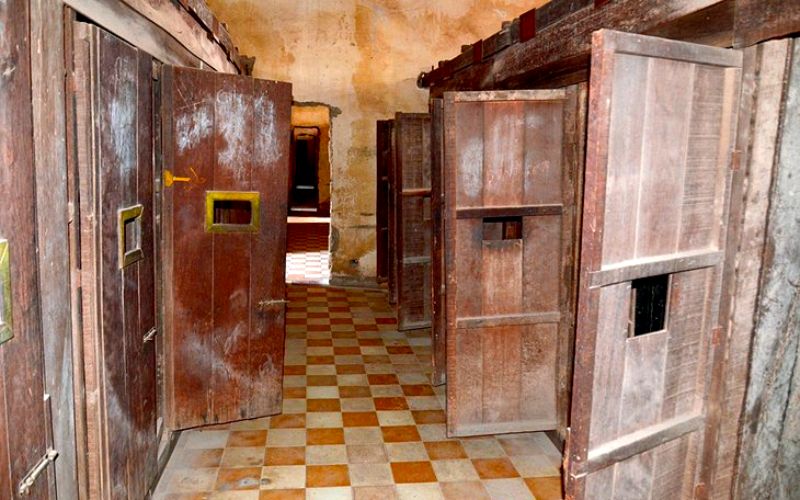
Tuol Sleng Museum
Between 1975 and 1978, more than 17,000 people walked through the gates, accused of betraying the revolution. Almost all of the prisoners brought here were once members of the Khmer Rouge, embittered during the regime’s many internal purges. The photographic evidence hanging on the walls of the sparse chamber next to the empty bed makes the experience of the visit even more visceral. S-21 was very well managed by Comrade Duch (guard) who made sure to take lots of records.
Central Market
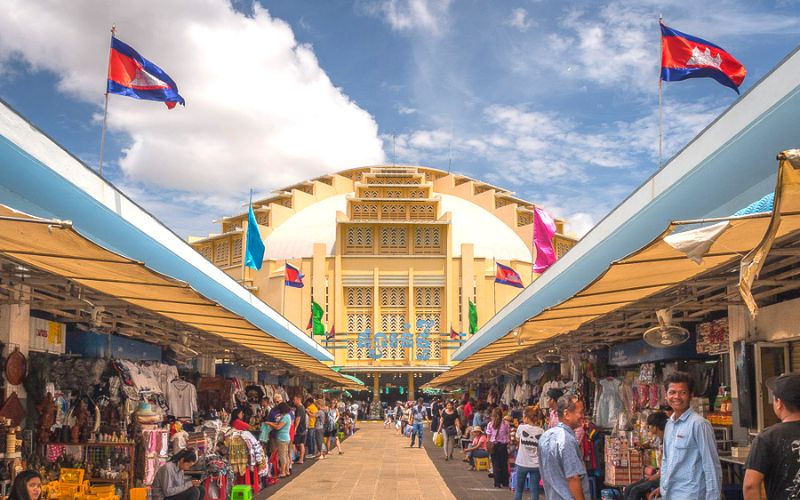
Central market
The Central Market, housed in an impressive art deco dome in the heart of Phnom Penh, is a veritable maze of stalls selling jewelry, electronics, antiques, spices, clothing, and souvenirs, among other things. After you’ve exhausted your shopping options, refuel with a local specialty from one of the market’s many food vendors.
Mekong River
Sisowath Quay runs for 3 kilometers along the banks of the Mekong and Tonlé Sap rivers and is bustling with activity at all hours of the day and night. Locals and tourists alike can be found admiring the view across the river, exploring the shops and art galleries, working out or playing games. Take a stroll at dusk and reward yourself with a drink at one of the many bars and restaurants that line this lively strip. From 17:00 to 19:30 there are regular sunset cruises that depart from the riverside and travel along the Tonle Sap and Mekong rivers.
What to eat & drink in Phnom Penh
Bai Sach Chrouk
Bai Sach Chrouk is a popular breakfast option throughout the country. From 5:30 p.m. onwards, a well-known vendor known as the Pork and Rice Man sells it on Street 19. The man is well-known for his marinated pork, which is the star of his stall. Locals and tourists alike flock here to sample the mouthwatering pork and rice.
Num Banh Chok
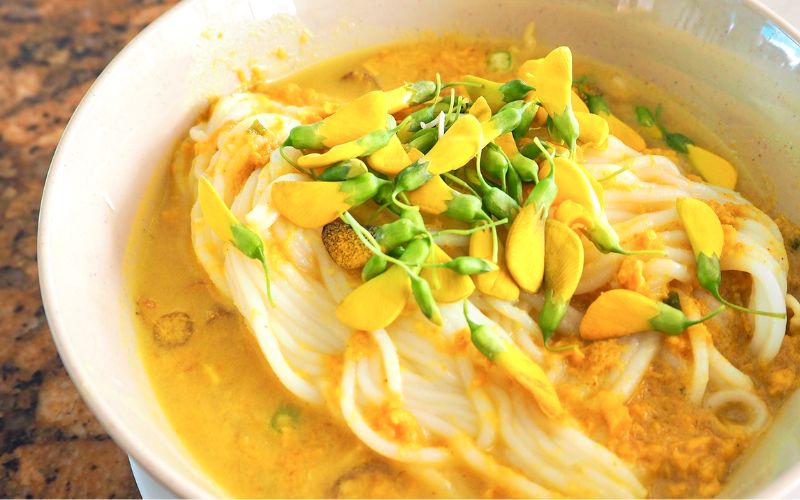
Num Banh Chok
It’s nearly impossible to walk a block in Phnom Penh without seeing someone eating Num Banh Chok, Cambodia’s national dish (Cambodian Noodles). These fermented rice noodles are made by hand in wooden mills and topped with fish curry, vegetables, lemongrass, turmeric root, and herbs such as basil and mint. This dish is a must-try and would be ideal for breakfast or brunch.
Nompang Sak Koh
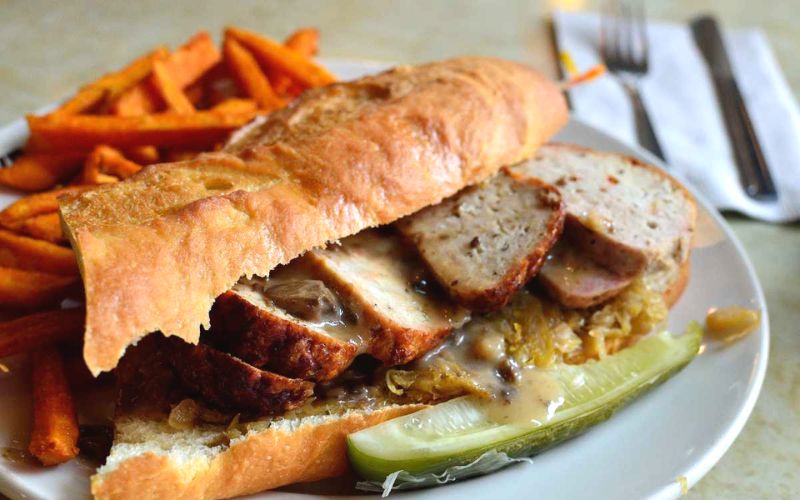
Nompang Sak Koh
Baguette bread, a relic left by the French colonists, can be found stacked on carts all over Phnom Penh. The Nompang Sak Koh consists of meatball gravy served with barbecued beef, pickled vegetables, and lemongrass inside a baguette, as well as green chili sauce, and is ideal for your taste buds. You can eat French-Cambodian delicacies at Phsar Chas or Old Market.
Fish Amok

Fish Amok
This is a Cambodian version of the popular Bengali dish ‘Fish Paturi,’ but with a different spice blend. The fish moose, as well as spices such as kaffir lime, lemongrass, and turmeric roots, are wrapped in banana leaf pockets and slowly steamed to allow the flavors to permeate the dish.
Khmer Coffee
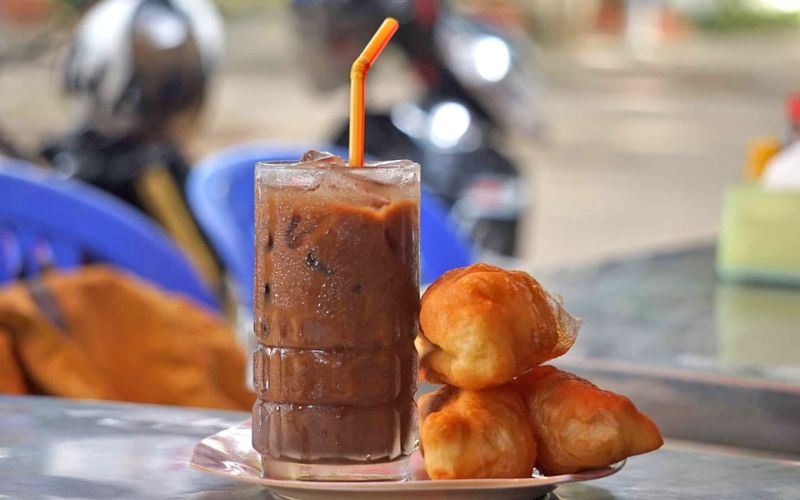
Khmer Coffee
Mondulkiri or Khmer Coffee Coffee has thrived in Southeast Asia since the French colonists first introduced it in the 1700s. This coffee is traditionally prepared by roasting it with vegetable fat until it turns black. After that, the coffee beans are finely ground to produce a dark and rich cup of coffee.
Travel tips
There are pickpockets in major cities so you must be aware. As a result, avoid walking at night, try to find a reliable motor driver, and don’t carry more than you need. When traveling, use common sense about the city’s chaotic traffic.
We hope you find the information in the article “Phnom Penh travel guide” useful. If you want more information and ideas for creating an unforgettable memory in Phnom Penh, feel free to contact us!